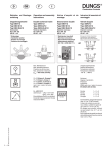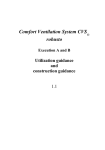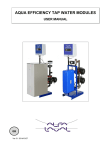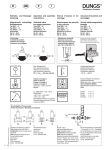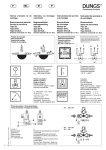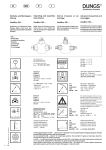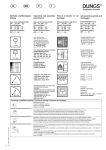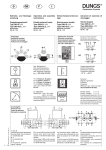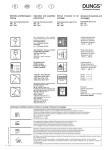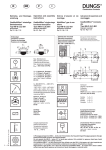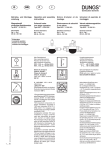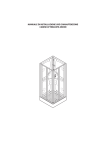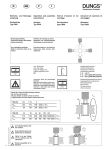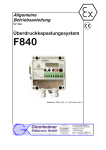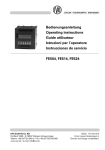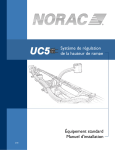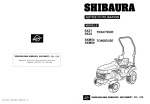Download D I GB F
Transcript
�� � � � Betriebsund Montage�� � anleitung Operation � and assembly � instructions Notice d’emploi et de montage Istruzioni d’uso e di montaggio Magnetventil einstufige Betriebsweise ��� �� Typ LV-D Solenoid valve Single-stage operation � Model�LV-D Électrovanne de sécurité Service à une allure Type LV-D Valvole elettromagnetiche monostadio Tipo LV-D Nennweiten Rp 2 ��� �� �� �� Nominal diameters Rp 2 �� �� � �� Diamètre nominal Rp 2 Diametri nominali Rp 2 Die Armatur LV-D eignet sich zum Absperren und Freigeben der Hauptgasmenge von nicht brennbaren Medien, stromlos geschlossen. Geeignet für verschmutzte Medien durch robusten elektromagnetischen Antrieb mit Faltenbalg. The LV-D valve is suitable for blocking or enabling the main flow of non-inflammable media (NC). Its sturdy bellows-type electromagnetic actuator makes it suitable for contaminated media. Le robinet LV-D est utilisé pour bloquer et libérer le débit de gaz principal de matériaux non combustibles, fermé hors tension . Il est approprié pour les matériaux souillés grâce à son entraînement électromagnétique robuste avec soufflet. L‘armatura LV-D è adatta per il blocco e la fuoriuscita della quantità di gas principale di sostanze non infiammabili, normalmente chiusa. Adatta per sostanze impure, mediante azionamento elettromagnetico resistente con soffietto. LV-D darf nicht für brennbare Gase eingesetzt werden; es sind ausschließlich nichtbrennbare, innerte Medien zulässig! The LV-D must not be used for inflammable gases; only non-inflammable inert media are allowed! Le LV-D ne doit pas être utilisé pour les gaz inflammables ; seuls les matériaux inertes non combustibles not autorisés ! LV-D non può essere impiegata per gas infiammabili; sono consentite esclusivamente sostanze non infiammabili e inerti. ��� � �� �� ��� Einbaulage �� �� � �� ��� Mounting position Position de montage Posizione di montaggio Elektrischer Anschluß Electrical connection Raccordement électrique Allacciamento elettrico IEC 730-1 (VDE 0631 T1) � Erdung nach örtlichen Vorschriften Grounding as per local regulations Mise à terre selon les normes locales Messa a terra secondo prescrizioni locali � � � � [mbar] Klasse A, Gruppe 2 Class A, Group 2 Classe A, Groupe 2 Classe A, Gruppo 2 in Anlehnung an / related to / conformément à / in conformità a EN 161 M/CD • Edition 02.10 • Nr. 252 622 Un ~(AC) 230 V –15 % +10 % 1 … 12 [V] oder / or / ou / o ~(AC) 110 V =(DC) 24 V- 28V Einschaltdauer/ Switch-on duration/ Durée de mise sous tension/ Ciclo di funzionamento 100 % °C +60 0 -15 IEC 529 � � � DC Max. Betriebsdruck Max. operating pressure Pression de service maximum Max. pressione di esercizio pmax. = 500 mbar (50 kPa) � � AC Umgebungstemperatur Ambient temperature Température ambiante Temperatura ambiente -15 °C … +60 °C Schutzart Degree of protection Protection Protezione IP 65 nach / acc. / selon / a norma IEC 529 (DIN EN 60 529) 3 Druckabgriffe / Pressure taps Prises de pression / Prese di pressione 1 (5) 2 4 Sieb Sieve Tamis Reticella LV-D 520 2 � � 3 Sieb 2 5 1 4 � � Sieve Tamis Reticella � 1, 2, 4, 3 Verschlußschraube Screw plug Bouchon fileté Tappo a vite G 1/8 DIN ISO 228 1 5 Anschlußmöglichkeit für Endkontakt Capability of connecting to final contact Possibilité de raccordement pour contact de fin de course Possibilità di attacco per finecorsa: K01/1 Verschlußschraube / Sealing plug Bouchon fileté / Tappo a vite G 1/8 DIN ISO 228 � � � Einbaumaße / Dimensions / Côte d‘encombrement / Dimensioni di ingombro [mm] � ��� � Platzbedarf für Magnetwechsel Space required for changing solenoid Encombrement pour le changement de l’électroaimant Spazio necessario per sostituzione bobina Typ Model Type Tipo Rp Pmax. [VA] Imax. ~(AC) 230 V Öffnungszeit Opening time Durée d’ouverture Tempo di apertura LV-D 520 Rp 2 50 0,22 A < 1 sec ISO 7005-2 19 [Nm] Einbaumaße / Dimensions / Côte d’encombrement / Dimensioni di ingombro [mm] e b a c d f g 238 165 114 370 126 39 Gewicht Weight Poids Peso [kg] 6,9 47 Verschluß- und Verbindungsschrauben sachgemäß anziehen. Werkstoffpaarung Druckguß – Stahl beachten! Tighten plug and union screws properly. Ensure die-cast – steel material combination! Serrer convenablement les vis de fermeture et de fixation. Respecter l’appariement des matériaux de moulage sous pression – acier! Stringere in modo appropriato sia le viti di collegamento che i tappi a vite. Prestare attenzione all’abbinamento dei materiali pressofusione – acciaio! 18 Max. Drehmomente / Systemzubehör Max. torques / System accessories Max. couple / Accessoires du système Coppie max. / Accessori di sistema M3 M4 M5 0,5 Nm 2,5 Nm 5 Nm M6 M8 G1/8 G1/4 7 Nm 15 Nm 2,5 Nm 7 Nm G1/2 G3/4 10 Nm 15 Nm M/CD • Edition 02.10 • Nr. 252 622 d � 2 … 12 Geeignetes Werkzeug einsetzen! Use proper tools! Utiliser des outils adaptés! Impiegare attrezzi idonei! M max. SV Tmax. M max. Schrauben kreuzweise anziehen! Tighten screws crosswise! Serrer les vis en croisant! Stringere le viti secondo uno schema a croce! Gerät darf nicht als Hebel benutzt werden! Do not use unit as lever! Ne pas utiliser la vanne comme levier! Non utilizzare la valvola a mo’ di leva! Rp Mmax. Tmax. 2 1100 250 [Nm] t ≤ 10 s [Nm] t ≤ 10 s Gewindeflanschausführung LV-D Ein- und Ausbau Threaded flange version LV-D Installation and disassembly Version à brides taraudées LV-D Montage / Démontage Esecuzione con flangia filettata LV-D Montaggio e smontaggio 1.Gewinde schneiden 1.Cut thread 1.Découper le filet 1.Eseguire la filettatura 2.Ausgangsflansch und Eingangsflansch (Option) auf die Rohrleitung montieren. Geeignete Dichtmittel verwenden, Bild 1. 2.Fit outlet and inlet flanges (optional) on the tubing Use appropriate sealing agent, Fig. 1. 2.Monter la bride de sortie et celle d’entrée (option) sur la conduite. Utiliser de la pâte à joints appropriée, fig. 1. 2.Montare la flangia di uscita e la flangia di ingresso (optional) sul tubo. Utilizzare sigillanti adeguati a tal scopo, Fig. 1. 3.Ventil eingangsseitig in die Rohrleitung montieren. Geeignetes Dichmittel verwenden. Lage der O-Ringe beachten, Bild 2. 3.Fit valve inlet side in the tubing. Use appropriate sealing agent. Note position of O rings, Fig. 2. 3.Monter la vanne dans la conduite, du côté de l’entrée. Utiliser des produits de bourrage appropriés. Attention aux joints toriques. Fig. 2. 3.Montare la valvola sul lato ingresso del tubo. Utilizzare un sigillante adeguato. Prestare attenzione alla posizione degli O-ring, Fig. 2. 4.Schrauben A, D, B, C anziehen. 4.Tighten screws A, D, B, C. 4.Serrer les vis A, D, B, C. 4.Stringere le viti A, D, B, C. 5.Nach Einbau Dichtheits- und Funktionskontrolle. 5.Carry out leakage and functional check after installation. 5.Après l’installation, contrôler l’étanchéité et le fonctionnement. 5.Dopo il montaggio, controllare la tenuta e il funzionamento. 6.Ausbau in umgekehrter Reihenfolge 4 ➞ 3 ➞ 2. 6.Disassembly in reverse order 4➞ 3 ➞ 2. 6.Démontage dans l’ordre inverse 4➞ 3 ➞ 2. 6.Effettuare lo smontaggio seguendo l’ordine inverso 4➞ 3 ➞ 2. 1 3 2 C D 5 M/CD • Edition 02.10 • Nr. 252 622 4 3 … 12 A B C D A B Degree of protection IP 65 Please note position of bobbin! Protection IP 65 Tenir compte de la positon de la bobine. Protezione IP 65 Prestare attenzione alla posizione della bobina. IP 65 OK ✓ IP 65 nein no non no IP 65 nein no non no IP 65 nein no non no M/CD • Edition 02.10 • Nr. 252 622 Schutzart IP 65 Magnetstellung beachten! 4 … 12 LV-D Hauptmengeneinstellung Setting the main flow Réglage du débit principal Regolazione portata principale 1 1 2 2 Lösen Unscrew Désserrer Allentare 3 Keine Gewalt anwenden Do not use force Ne pas forcer Non sforzare – + ∆p ° ∆V M/CD • Edition 02.10 • Nr. 252 622 min./mini 5 … 12 max./maxi. Werkseinstellung Factory setting Réglage d‘usine Regolazione in fabricca ° ° V = 0,1 x V min./mini. max./maxi. [m 3 /h] Replacing adjustment plate 1. Anlage ausschalten. 2. Sicherungslack über der Senkkopfschraube A entfernen. 3. Senkkopfschraube A ausschrauben. 4. Zylinderkopfschraube B ausschrauben. 5. Einstellteller C abheben. 6. Einstellteller C austauschen. 7. Senk- und Zylinderkopfschraube wieder eindrehen. Senkkopfschraube nur so festziehen, daß Einstellteller noch gedreht werden kann. 8. Senkkopfschraube A mit Sicherungslack überziehen. 9. Dichtheitsprüfung über Druckabgriff Verschlußschraube 3: SV... pmax. = 500 mbar 10. Funktionskontrolle durchführen. 11. Anlage einschalten. 1. 2. 3. Switch installation off. Remove locking varnish from countersunk screw A. Unscrew countersunk screw A. 4. Unscrew socket head screw B. 5. Lift off adjustment plate C. 6. Replace adjustment plate C. 7. Screw in countersunk and socket head screws again. Tighten countersunk screw so that adjustment plate can only just be turned. 8. Coat countersunk screw A with locking varnish. 9. Leakage test via pressure tap screw plug 3: SV... pmax. = 500 mbar 10. Carry out functional test. 11. Switch installation on. A C B Remplacement du disque de réglage Sostituzione del disco di regolazione 1. Mettre l’installation hors tension. 2. Éliminer le vernis de blocage audessus de la vis à tête fraisée A. 3. Dévisser la vis à tête fraisée A. 4. Dévisser la vis à tête cylindrique B. 1. Disinserire l’impianto. 2. Rimuovere la lacca di sigillo sopra la vite a testa svasata A. 3. Svitare la vite a testa svasata A. 4. Svitare la vite a testa cilindrica B. 5. Soulever le disque de réglage C. 6. Remplacer le disque de réglage C. 7. Revisser les vis à tête fraisée et à tête cylindrique. Serrer la vis à tête fraisée jusqu’à un point où l’on peut encore faire tourner le disque de réglage. 8. Enduire la vis à tête fraisée A de vernis de blocage. 9. Contrôle d’étanchéité via la prise de pression du bouchon fileté 3: SV... pmax. = 500 mbar 10. Procéder à un contrôle de fonctionnement. 11. Mettre l’installation sous tension. 5. Sollevare il disco di regolazione C. 6. Sostituire il disco di regolazione C. 7. Riavvitare la vite a testa cilindrica e stringere la vite a testa svasata lasciando che il disco di regolazione possa ancora ruotare. 8. Sigillare con la lacca la vite a testa svasata A. 9. Prova di tenuta attraverso il tappo a vite della presa di pressione 3: SV... pmax. = 500 mbar 10. Effettuare la prova di funzionamento. 11. Reinserire l’impianto. M/CD • Edition 02.10 • Nr. 252 622 Austausch Einstellteller 6 … 12 Sieb reinigen Cleaning the sieve Nettoyer le tamis Pulire la reticella 1.Gaszufuhr unterbrechen: Kugelhahn schließen! 2.Schrauben 1 - 4 herausdrehen, auf O-Ring (A) achten. 3.Metallsieb (B) herausnehmen. 4.Metallsieb (B) reinigen. 5.Metallsieb wieder einführen; auf Führung im Gehäuse achten. 6.O-Ring einsetzen. 7.Bodendeckel einsetzen. 8.Schrauben 1 - 4 ohne Gewalt hineindrehen und anziehen. 1.Interrupt the gas supply: close the ball valve! 2.Unscrew screws 1 - 4, pay attention to the O-ring (A). 3.Remove the metal sieve (B). 4.Clean the metal sieve (B). 5.Insert the metal sieve again; pay attention to the guidance in the housing. 6.Insert the O-ring. 7.Insert the bottom cover. 8.Screw in screws 1 - 4 without applying any force and tighten them. 1.Couper l‘arrivée du gaz : fermer le robinet à tournant sphérique ! 2.Desserrer les vis 1 - 4, faire attention au joint torique (A). 3.Enlever le tamis métallique (B). 4.Nettoyer le tamis métallique (B). 5.Insérer le tamis métallique ; faire attention au guidage dans le boîtier. 6.Insérer le joint torique. 7.Insérer le couvercle de fond. 8.Poser le vis 1 - 4 sans force et les serrer. 1.Interrompere l‘alimentazione di gas: chiudere il rubinetto a sfere! 2.Svitare le viti 1 - 4 facendo attenzione all‘anello torico (A). 3.Togliere la reticella metallica (B). 4.Pulire la reticella metallica (B). 5.Introdurre di nuovo la reticella metallica, facendo attenzione alla guida nel corpo. 6.Applicare l‘anello torico. 7.Applicare il coperchio di fondo. 8.Avvitare e stringere senza forza le viti 1 - 4. B M/CD • Edition 02.10 • Nr. 252 622 A 7 … 12 3 1 4 2 Bypassbohrung anbringen Producing a bypass bore Faire un alésage bipasse Eseguire un foro per bypass. Die Armatur ist bereits für eine Bypassbohrung vorbereitet. Maximaler Durchmesser der Bypassbohrung 15,0 mm. 1. Gaszufuhr unterbrechen: Kugelhahn schließen! 2. Schrauben 1 - 4 herausdrehen, auf O-Ring (A) achten. 3. Schraube C ausschrauben. 4. Durch ausgeschraubte Bohrung C entstandene Bohrung aufbohren; max. Bohrungsdurchmesser 15,0 mm. 5. Bohrung auf Durchgang prüfen. 6. Späne entfernen - zur Sicherheit Sieb ebenfalls reinigen. 7. Metallsieb wieder einführen; auf Führung im Gehäuse achten. 8. O-Ring einsetzen. 9. Bodendeckel einsetzen. 10. Schrauben 1 - 4 ohne Gewalt hineindrehen und anziehen. The device is already prepared for a bypass bore. The maximum diameter of the bypass bore is 15.0 mm. 1. Interrupt the gas supply: close the ball valve! 2. Unscrew screws 1 - 4, pay attention to the O-ring (A). 3. Unscrew screw C. 4. Open the bore created by the unscrewed bore C by boring; the maximum bore diameter is 15.0 mm. 5. Check the bore for free transit. 6. Remove chips - for safety reasons, clean also the sieve. 7. Insert the metal sieve again; pay attention to the guidance in the housing. 8. Insert the O-ring. 9. Insert the bottom cover. 10. Screw in screws 1 - 4 without applying any force and tighten them. Le robinet est déjà préparé pour un alésage bipasse. Le diamètre maximal de l‘alésage bipasse est 15,0 mm. 1. Couper l‘arrivée du gaz : fermer le robinet à tournant sphérique ! 2. Desserrer les vis 1 - 4, faire attention au joint torique (A). 3. Desserrer la vis C. 4. Aléser le trou produit par l‘alésage desserré ; le diamètre maximal de l‘alésage est 15,0 mm. 5. Vérifier le passage de l‘alésage. 6. Enlever les copeaux - par sécurité, nettoyer également le tamis. 7. Insérer le tamis métallique ; faire attention au guidage dans le boîtier. 8. Insérer le joint torique. 9. Insérer le couvercle de fond. 10. Poser le vis 1 - 4 sans force et les serrer. L‘armatura è già pronta per un foro per bypass. Diametro massimo del foro di bypass: 15,00 mm. 1. Interrompere l‘alimentazione di gas: chiudere il rubinetto a sfere! 2. Svitare le viti 1-4 facendo attenzione all‘anello torico (A). 3. Svitare e togliere la vite C. 4. Allargare il foro formatosi togliendo la vite C; diametro massimo del foro: 15,00 mm. 5. Verificare il passaggio del foro. 6. Rimuovere i trucioli - per sicurezza pulire anche la reticella. 7. Reintrodurre la reticella metallica facendo attenzione alla guida nel corpo. 8. Applicare l‘anello torico. 9. Appicare il coperchio di fondo. 10. Avvitare e stringere senza forza le viti 1-4. C Magnetwechsel LV-D Solenoid replacement LV-D Remplacement de l’aimant LV-D Sostituzione bobina LV-D 1.Einstellteller entfernen, wie auf Seite 7 “Austausch Einstellteller”, Punkt 1 - 5, beschrieben. 1.Remove adjustment plate, as described on page 7 “Replacing adjustment plate” points 1 - 5. 1.Déposer le disque de réglage, comme indiqué en page 7 « Remplacement du disque de réglage », points 1 à 5. 1.Rimuovere il disco di regolazione, come descritto a pagina 7 “Sostituzione del disco di regolazione”, punti 1 - 5. 2.Magnet auswechseln. Magnet-Nr. und Spannung unbedingt beachten! 2.Replace solenoid. Always observe solenoid No. and voltage! 2.Remplacer l’aimant. Tenir impérativement compte de la réf. de l’aimant et de la tension! 2.Sostituire la bobina. Rispettare tassativamente il n. della bobina e la tensione! 3.Einstellteller wieder montieren, wie auf Seite 7 “Austausch Einstellteller”, Punkt 7 - 11, beschrieben. 3.Refit adjustment plate, as described on page 7 “Replacing adjustment plate” points 7 - 11. 3.Remonter le disque de réglage comme indiqué en page 7 «Remplacement du disque de réglage», points 7 à 11. 3.Rimontare il disco di regolazione, come descritto a pagina 7 “Sostituzione del disco di regolazione”, punti 7 - 11. Nach Magnetwechsel TypAufkleber auf dem Magnet anbringen! Attach model-sticker to solenoid after replacement! Après le remplacement de l’aimant, y apposer l’affichette de type! Una volta sostituita la bobina, apporre l’adesivo del tipo sulla bobina stessa! C B M/CD • Edition 02.10 • Nr. 252 622 A 8 … 12 LV-D 520 Durchfluß-Diagramm / Flow Diagram / Diagramme de débit / Diagramma di portata 200 100 90 80 70 60 50 40 30 ∆p [mbar] 20 10 9 8 7 6 5 4 3 2 1,0 0,9 0,8 0,7 0,6 0,5 0,4 Basis Based on Base Base 0,3 + 15° C, 1013 mbar, trocken + 15° C, 1013 mbar, dry + 15° C, 1013 mbar, sec + 15° C, 1013 mbar, secco 0,2 1 1 ° [m3/h] Luft/Air/Aria dv = 1,00 Vn 2 4 6 8 10 20 40 60 80 100 200 400 600 800 1000 ° [m3/h] Erdgas/Natural gas/Gaz Naturel/Gas metano dv = 0,65 Vn 2 4 6 8 10 20 40 60 80 100 200 400 600 800 1000 Strömungsgeschwindigkeit / Flow velocity / Vitesse d‘écoulement / Velocità Flusso 200 Empfohlener Arbeitsbereich Recommended working range Zone de travail recommandée Campo di lavoro raccomandato 150 125 100 80 DN, DIN 2441 65 50 40 32 30 25 20 5 10 M/CD • Edition 02.10 • Nr. 252 622 s m/ 20 s m/ s m/ Strömungsgeschwindigkeiten in schweren Gewinderohren nach DIN 2441 Flow velocities in heavy threaded tubes as per DIN 2441 Vitesses d‘écoulement dans les tuyaux filetés lourds en fonction de la norme DIN 2441 Velocità di flusso in tubi filettati pesanti a norma DIN 2441 s 30 m/s s 50 m/ 70 s m/ 0 10 10 9 8 7 6 1 9 … 12 m/ 2 4 6 8 10 20 40 60 80 100 Basis Based on Base Base 200 400 + 15 °C, 1013 mbar, trocken + 15 °C, 1013 mbar, dry + 15 °C, 1013 mbar, sec + 15 °C, 1013 mbar, secco 600 800 1000 2000 ° [m3/h] Erdgas/Natural gas/Gaz Naturel/Gas metano dv = 0,65 Vn 4000 Ersatzteile / Zubehör Spare parts / Accessories Pièces de rechange / access. Parti di ricambio / Accessori Bestell-Nummer Order No. No. de commande Codice articolo Verschlußschraube, flach mit O-Ring Screw plug, flat with O ring Bouchon fileté Tappo a vite, testa piana con O-ring G 1/8 5 Stück / Set 5 Pieces / Set 5 Pièces / Set 5 Pezzi / Set 230 432 Set Zündgasflansch G1/2 G1/2 ignition gas flange set Kit de bride taraudée G 1/2 Set per flangia gas di accensione G 1/2 LV-D 520 219 007 Einsteckscheibe Insert washer Disque à emboîtement Disco ad innesto LV-D 520 231 563 Leitungsdose, Schwarz Line socket, black Prise, noire Connettore, nero GDMW, 3 pol. + E 210 319 Anschlußflansch Connecting flange Bride de raccordement Flangia di collegamento LV-D 520 LV-D 520 LV-D 520 LV-D 520 Rp 1 Rp 1 1/4 Rp 1 1/2 Rp 2 242 227 242 228 242 229 242 230 Meßstutzen mit Dichtring Instrument gland with sealing ring Goujon Attacco misuratore con anello di tenuta G 1/8 230 397 Ersatzmagnet Replacement solenoid Aimant de rechange Bobina di ricambio auf Anfrage on request sur demande su richesta Leiterplatte Replacement solenoid Carte imprimée Scheda circuito stampato auf Anfrage on request sur demande su richesta LV-D 241 148 Dichtungen für Flansche Measuring connections with sealing ring Prise de pression avec joint guarnizioni per flange 2 Stück/Set 2 Pieces/Set 2 Pièces/Set 2 Pezzi/Set LV-D 520 230 444 M/CD • Edition 02.10 • Nr. 252 622 Einstellteller für Hauptmenge Adjustment plate for main flow Réglage de débit principal Disco di regolazione portata principale 10 … 12 Safety first M/CD • Edition 02.10 • Nr. 252 622 O.K. 11 … 12 Arbeiten am Magnetventil dürfen nur von Fachpersonal durchgeführt werden. Work on the solenoid valve may only be carried out by specialist personnel. Seul du personnel spécialisé peut effectuer des travaux à l’électrovanne. Qualsiasi operazione effettuata sulle valvole deve essere eseguita da personale competente. Flanschflächen schützen. Schrauben kreuzweise anziehen. Auf mechanisch spannungsfreien Einbau achten. Protect flange faces. Tighten screws crosswise! Ensure freedom from mechanical strain. Protéger les surfaces des brides. Serrer les vis en croisant. Éviter les tensions mécaniques lors du montage. Proteggere le superfici della flangia. Stringere le viti secondo uno schema a croce. Evitare tensioni meccaniche in sede di montaggio. Direkter Kontakt zwischen Magentventil und dem aushärtendem Mauerwerk, Betonwänden, Fußböden ist nicht zulässig. Do not allow any direct contact between the solenoid and hardened masonry, concrete walls or floors. Éviter tout contact direct entre l’électrovanne et la maçonnerie, les cloisons en bétons et planchers en cours de séchage. Evitare ogni contatto diretto fra la valvola e opere murarie, pareti in calcestruzzo e pavimenti non ancora perfettamente assestati. Grundsätzlich nach Teileausbau/-umbau neue Dichtungen verwenden. Always use new seals after dismounting / modifying parts. Après un démontage ou une modification, toujours utiliser des joints neufs. In linea di massima, dopo lo smontaggio e il rimontaggio di alcune parti, utilizzare nuove guarnizioni. Rohrleitungsdichtheitsprüfung: Kugelhahn vor den Armaturen / SV… schließen. Tubing leakage test: Close ball valve in front of fittings / SV... Contrôle de l’étanchéité de la conduite: Fermer le robinet à boisseau sphérique avant les accessoires de tuyaux / SV… Per la prova di tenuta delle tubature: chiudere il rubinetto a sfera a monte delle valvole/ SV… Nach Abschluß von Arbeiten am Magnetventil: Dichtheits- und Funktionskontrolle durchführen. On completion of work on the solenoid valve: carry out leakage and functional tests. Une fois les travaux terminés à l’électrovanne: Procéder à un contrôle de fonctionnement. Al termine dei lavori effettuati su una valvola elettromagnetica: eseguire un controllo sia della tenuta che del funzionamento. Niemals Arbeiten durchführen, wenn Gasdruck oder Spannung anliegt. Offenes Feuer vermeiden. Öffentliche Vorschriften beachten. Never carry out work if gas pressure or power is applied. No naked flames. Observe public regulations. Ne jamais effectuer de travaux lorsque la pression ou la tension sont présentes. Éviter toute flamme. Respecter les réglementations. Non eseguire mai lavori in presenza di gas in pressione o di tensione elettrica. Evitare i fuochi aperti e osservare le normative. Bei Nichtbeachtung der Hinweise sind Personenoder Sachfolgeschäden denkbar. Non-observance of these instructions may result in personal injury or property damage. Le non-respect de ces instructions peut entraîner des dommages corporels et matériels. La non osservanza di quanto sopra può ingenerare danni alle persone o alle cose. Alle Einstellungen und Einstellwerte nur in Übereinstimmung mit der Betriebsanleitung des Kessel-/Brennerherstellers ausführen. Any adjustment and application-specific adjustment values must be made in accordance with the appliance-/boiler manufacturers instructions. Effectuer tous les réglages et réaliser les valeurs de réglage uniquement selon le mode d'emploi du fabricant de chaudières et de brûleurs. Realizzare tutte le impostazioni e i valori impostati solo in conformità alle istruzioni per l'uso del costruttore della caldaia/ del bruciatore. Änderungen, die dem technischen Fortschritt dienen, vorbehalten / We reserve the right to make alterations in the course of technical improvement/ Sous réserve de modifications servant au progrès technologique / La società si riserva qualsiasi modifica tecnica e costruttiva Hausadresse Head Offices and Factory Usine et Services Administratifs Amministrazione e Stabilimento Karl Dungs GmbH & Co. KG Siemensstr. 6-10 D-73660 Urbach, Germany Telefon+49 (0)7181-804-0 Telefax+49 (0)7181-804-166 Briefadresse Postal address Adresse postale Indirizzare la corrispondenza a Karl Dungs GmbH & Co. KG Postfach 12 29 D-73602 Schorndorf e-mail [email protected] Internet www.dungs.com �� � �� ��� �� ��� �� �� �� ��� � �� �� � � Die Druckgeräterichtlinie (PED) und die Richtlinie über die Gesamtenergieeffizienz von Gebäuden (EPBD) fordern eine regelmässige Überprüfung von Heizungsanlagen zur langfristigen Sicherstellung von hohen Nutzungsgraden und somit geringster Umweltbelastung. Es besteht die Notwendigkeit sicherheitsrelevante Komponenten nach Erreichen ihrer Nutzungsdauer auszutauschen. Diese Empfehlung gilt nur für Heizungsanlagen und nicht für Thermprozessanwendungen. DUNGS empfiehlt den Austausch gemäss folgender Tabelle: � �� � �� � � Sicherheitsrelevante Komponente Safety relevant component Composant relatif à la sécurité Componenti rilevanti dal punto di vista della sicurezza ��� �� � The Pressure Equipment Directive (PED) and the Energy Performance of Buildings Directive (EPBD) require a periodic inspection of heating appliances in order to ensure a high degree of efficiency over a long term and, consequently, the least environmental pollution. It is necessary to replace safety-relevant components after they have reached the end of their useful life. This recommendation applies only to heating appliances and not to industrial heating processes. DUNGS recommends replacing such components according to the following table: �� � �� �� ��� Ventilprüfsysteme / Valve proving systems Systèmes de contrôle de vannes / Sistemi di controllo valvole Druckwächter / Pressure switch / Manostat / Pressostati Feuerungsmanager mit Flammenwächter Automatic burner control with flame safeguard Dispositif de gestion de chauffage avec contrôleur de flammes Gestione bruciatore con controllo fiamma UV-Flammenfühler Flame detector (UV probes) Capteur de flammes UV Sensore fiamma UV La directive concernant les chauffe-bains à pression (PED) et la directive sur la performance énergétique des bâtiments (EPBD) exigent une vérification régulière des installations de chauffage, afin de garantir à long terme des taux d‘utilisation élevés et par conséquent une charge environnementale minimum. Il est nécessaire de remplacer les composants relatifs à la sécurité lorsqu‘ils ont atteint la fin de leur vie utile. Cette recommandation ne s‘applique qu‘aux installations de chauffage et non aux applications de processus thermique. DUNGS recommande le remplacement, conformément au tableau qui suit : La direttiva per apparecchi a pressione (PED) e la direttiva per l‘efficienza dell‘energia totale per edifici (EPBD), esigono il controllo regolare degli impianti di riscaldamento per la garanzia a lungo termine di un alto grado di rendimento e con ciò di basso inquinamento ambientale. Ciò rende necessaria la sostituzione di componenti rilevanti dal punto di vista della sicurezza alla scadenza della loro durata di utilizzazione. Questo suggerimento vale solo per impianti di riscaldamento e non per impieghi per processi termici. DUNGS consiglia detta sostituzione in conformità alla sottostante tabella: NUTZUNGSDAUER DUNGS empfiehlt den Austausch nach: USEFUL LIFE DUNGS recommends replacement after: VIE UTILE DUNGS recommande le remplacement au bout de : DURATA DI UTILIZZAZIONE DUNGS consiglia la sostituzione dopo: Schaltspiele Operating cycles Cycles de manoeuvres Cicli di comando 10 Jahre/years/ans/anni 250.000 10 Jahre/years/ans/anni N/A 10 Jahre/years/ans/anni 250.000 10.000 h Betriebsstunden / Operating hours Heures de service / Ore di esercizio Gasdruckregelgeräte / Gas pressure regulators Dispositifs de réglage de pression du gaz / Regolatori della pressione del gas 15 Jahre/years/ans/anni Gasventil ohne Ventilprüfsystem* / Gas valve without valve testing system* Vanne de gaz sans système de contrôle de vanne* / Valvola del gas senza sistema di controllo valvola* 10 Jahre/years/ans/anni 250.000 10 Jahre/years/ans/anni N/A 10 Jahre/years/ans/anni N/A 10 Jahre/years/ans/anni N/A Gasventil mit Ventilprüfsystem / Gas valve with valve testing system Vanne de gaz avec système de contrôle de vanne / Valvola del gas con sistema di controllo valvola Min. Gasdruckwächter / Low gas pressure switch Manostat de gaz min. / Pressostato gas min. Sicherheitsabblaseventil / Pressure relief valve Soupape d‘évacuation de sécurité / Valvola di scarico di sicurezza Gas-Luft-Verbundsysteme / Gas-air ratio control system Systèmes combinés gaz/air / Sistemi di miscelazione gas-aria * Gasfamilien I, II, III / Gas families I, II, III Familles de gaz I, II, III / per i gas delle famiglie I, II, III N/A nach erkanntem Fehler / after error detection après détection du défaut / dopo il rilevamento di errori N/A kann nicht verwendet werden / not applicable ne peut pas être utilisé / non può essere usato Änderungen, die dem technischen Fortschritt dienen, vorbehalten / We reserve the right to make modifications in the course of technical development. Sous réserve de tout modification constituant un progrès technique / Ci riserviamo qualsiasi modifica tecnica e costruttiva Hausadresse Head Offices and Factory Usine et Services Administratifs Amministrazione e Stabilimento Karl Dungs GmbH & Co. KG Siemensstr. 6-10 D-73660 Urbach, Germany Telefon+49 (0)7181-804-0 Telefax+49 (0)7181-804-166 Briefadresse Postal address Adresse postale Indirizzare la corrispondenza a Karl Dungs GmbH & Co. KG Postfach 12 29 D-73602 Schorndorf e-mail [email protected] Internet www.dungs.com M/CD • Edition 02.10 • Nr. 252 622 � 12 … 12













